

 Kinds of writing in the history of English
Kinds of writing in the history of English
Literary forms
Non-fictional literature
Journalistic literature
The linguistic value of different text types
The present section offers a summary discussion of text types which are available throughout the history of English. Names of individual works, and in some cases details, can be found in the remaining sections of the current option group.
It is obvious that the knowledge of previous stages of English is handed down to us in the form of texts. These come in various guises and the task of the historical linguist is to determine to what extent the genre which a text represents affected the manner in which the author used the language variety spoken at his/her time. This question is not trivial: there are texts which one can assume are quite far removed from spoken language, such as translations from Latin, and others, such as comedies, satires or parodies, which are much more likely to embody colloquial speech.
For the investigation of the history of English, the question of text type - or genre - needs to be addressed. Not least because, as linguists have recently pointed out, a structure, such as the gerund in English, may have spread in a certain style of writing and later have had an influence on spoken speech, so that the existence of certain text types can promote a particular type of linguistic change.
Different text types entail the use of different styles. It is common in poetry, most probably in epic poetry (such as Old English Beowulf) that archaic language is used to create a distinctive atmosphere within the text. Other text types are restricted in their stylistic range, for instance ecclesiastical texts, whether translations or not, are usually quite confined in the varieties of language which they evince. Such texts are very unlikely to contain colloquial language. Furthermore, a text may be formulaic in character, e.g. ritual religious texts or inscriptional texts such as Old English runes. Later text types, such as epistolary novels, may contain many formulaic elements.
In summary, one can say that various parameters can influence the type of language which a text shows and hence this must be considered when extrapolating from the language used by an author to that which is assumed to have been spoken in the society of the time. Some of the relevant parameters are shown in the following list.
This period contains both original texts and translations. It starts with runes and inscriptions, both of which are formulaic in character. Early texts include glossaries, providing English translations of Latin words and expressions. Larger translations also exist, for instance of the four gospels and there are prefaces by King Alfred (848-899) to translations which he either did himself or commissioned. There is much poetic material, such as the elegies and smaller poems. The monk Caedmon (7th century) was the first to compose a hymn. Later poetry was both of a religious and a secular nature. And of course there is the main English epic, Beowulf.
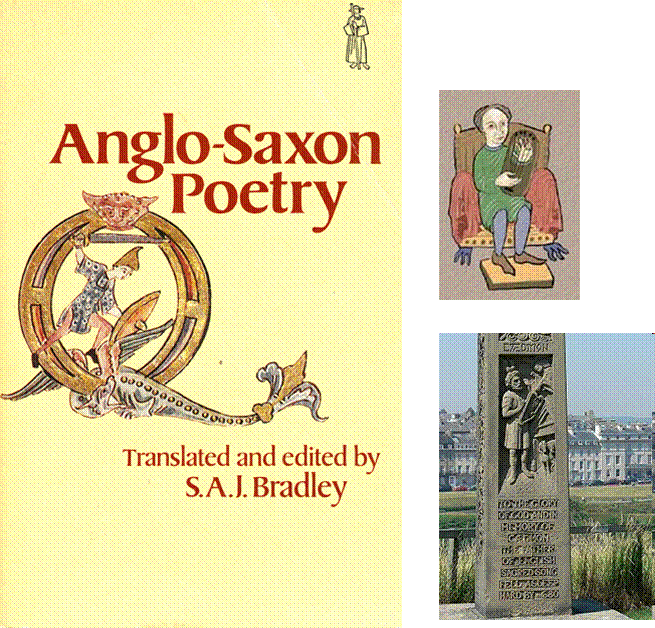
A specific genre of historical writing is available in the Old English period, the chronicle, which consists of brief entries for various years and which recount important military events, especially during the Scandinavian period.
.gif)
Edition of the |
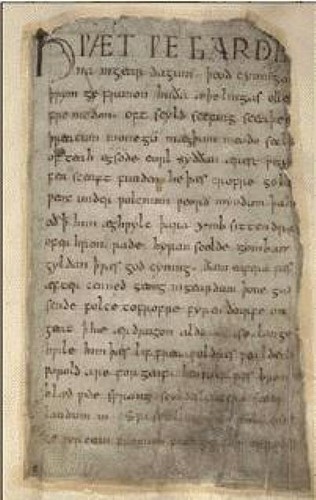
Opening lines of the |
.gif) Seamus Heaney’s recent translation of Beowulf |
Middle English period
There is greater variety among the texts of the Middle English period. It begins with some remnants of the Old English chronicle, e.g. in the Peterborough Chronicle from around the mid 12th century, followed by poetic works like The Owl and the Nightingale (late 12th century).
|
Opening page of the |
The Owl and the Nightingale |
The 13th and 14th centuries saw a great flourishing in text types and culminated in the works of Geoffrey Chaucer in the late 14th century. In his main work, The Canterbury Tales, Chaucer illustrates many of the literary genres popular at his time. The Middle English period also contains much religious writing, some of it hagiographical (about the lives of saints) for instance the well-known South English Legendary, and some of it instructional, for instance the Ancrene Wisse ‘The guide for anchoresses (head nuns)’.
Some literary forms of the Middle English period
Morality plays, allegorical plays in which the figures represent human qualities which engaged in disputes. The most famous is Everyman, a short play of 921 lines from the beginning of the 16th century.
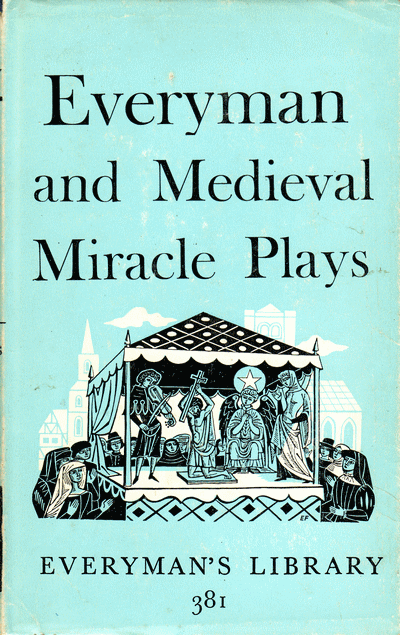
The morality plays are the precursor of later naturalistic plays which then, in the later 16th century, led to Elizabethan drama. There is also a group called Mystery Plays (the term refers to the trade of the performers and not to an unsolved mystery) which deal with biblical themes and are associated with feasts of the church calendar such as Corpus Christi. Mystery plays were popular between the 13th and 16th centuries.
Fabliau, a short tale recounted in verse and dealing in comic form with some incident from everyday life exemplified in English by Chaucer’s The Miller’s Tale.
Romance, courtly stories in verse, such as Sir Gawain and the Green Knight, which involve chivalric figures such as King Arthur, Charlemagne or others associated with them and generally interweave magical and supranatural elements to make a moral point. There are many Arthurian legends from the later Middle English period, the most important of which is the cycle known as Le Morte D'Arthur (completed c. 1470) by Sir Thomas Malory (died 1471).
Breton Lays, short stories in rhyme in the style of Marie de France (French poet from about 1160-90 whow wrote 12 lays) and exemplified in English by Chaucer’s The Franklin’s Tale.
Travel literature arose in the Middle English period, especially with the immensely popular The Travels of Sir John Mandeville, a 14th century Anglo-Norman text (surviving in many English manuscripts) which initiated a long fascination with the orient (whether genuinely portrayed or not). At this time the question of whether the travels actually took place was irrelevant, the popularity derived from the description of foreign places and customs.
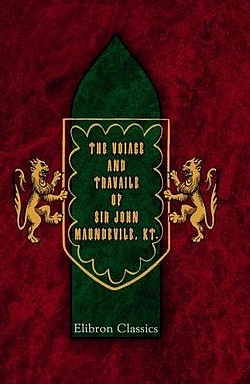
The Travels of Sir John Mandville
Early Modern period
Drama So great is the figure of Shakespeare that drama of the early modern period is associated primarily with his name. Certainly he furthered drama enormously, building on foundations which were laid in the later Middle English period with the morality and mystery plays. Elizabethan drama in general can be divided into three types, (i) comedy, (ii) tragedy and (iii) historical drama all of which are amply represented in the works of Shakespeare. Given the generally elevated tone of tragedy and historical drama, the language is assumed to be of a higher register and hence not as indicative of colloquial speech as that in comedy, although in Shakespeare there are exceptions such as the gravedigger’s scene in Hamlet, the knocking on the gate in Macbeth or the four nations scene in Henry V.
Poetry Poetic literature continued through the early modern period in an unbroken fashion. There are larger works such as The Faire Queene by Edmund Spenser (c. 1552-1599) and the epic works of John Milton (1608-74), see section on Early Modern English Writings.
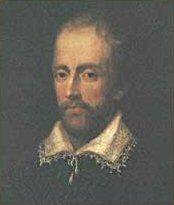 Edmund Spenser |
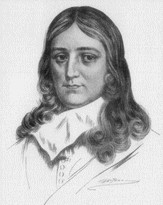 John Milton |
A form which was particularly popular was the sonnet (first popularised in European literature by the Italian poet Francesco Petrarca, 1304-1374) which had a strict form of 14 lines, the last two forming a rhyming couplet.
Novel This a term which derives from Italian novella, originally referring to a tale in the Decamerone by Giovanni Boccaccio (1313-1375). The label is used for a large piece of narrative fiction usually covering a considerable span of time and involving a series of characters and told by a narrator (of which there are different types). The novel arose in 18th century England as a major literary genre with authors like Daniel Defoe (1660-1731), Samuel Richardson (1689-1761), Henry Fielding (1707-1754), Tobias Smollett (1721-1771) and Laurence Sterne (1713-1768). Many of the first novels were in epistolary form, that is they consisted of letters supposedly written by the characters of the novel to one another.
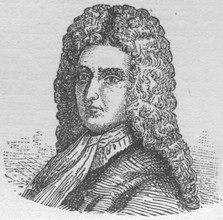 Daniel Defoe |
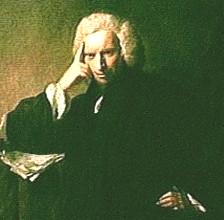 Laurence Sterne |
Non-fictional literature
Personal correspondence
In recent years, much attention has been given by linguists working in historical sociolinguistics to private letters as a source of information on language use and language change. From the Middle English period onwards there are collections of letters which have been preserved, frequently consisting of the correspondence between members of a particular family, and which give insights into English of the time. One of the most famous families is the Paston family from Norfolk the members of which wrote a large number of letters to each other between about 1420 and 1504. Other sets of letters are the Stonor letters and the Lisle letters. Such collections exist for other varieties of English as well. The McMahon letters from 18th century Ireland offer insights into the nature of Irish English at the time. The letters in all these cases typically involve relationships within the family, business dealings and petitions from people outside the family to prominent members within (as with the Lisle and the McMahon letters).
Technical literature
The early modern period sees the rise of literature of a technical nature. The great expansion in the natural sciences, one of the main legacies of the Renaissance, led to literature dealing with scientific topics. With regard to language, one can note the appearance in the 16th century and later of a large body of literature concerned with the structure of English, its orthography, pronunciation, grammar and vocabulary. One of the first and most important authors in this field is John Hart (died 1574), the author of An orthographie of English (1569), one of the first works which suggested a spelling reform for English. See the gallery of writers from the early modern period for information on other authors.
In the 18th century a tradition arose which came to be called the prescriptive tradition. The main works from this sphere are grammars which lay down rules for the supposedly correct use of English. Of the many authors who have become known in this field, the most significant (in terms of influence) in Bishop Lowth, the author of a prescriptive grammar. One should also mention the elocutionist tradition, concerned with acceptable, i.e. standard, pronunciation of English, which flourished in the late 18th century with figures like Sheridan and Walker (see module on Standardisation further details).
Journalistic literature
Pamphlets
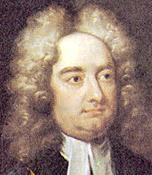
|
A pamphlet is a piece of polemical writing, a booklet, aimed at a large audience. Pamphlets arose during the Reformation period as a means of spreading radical religious and political views and continued until well into the 18th century, for instance with the author Jonathan Swift (1667-1745). |
Periodicals
Weekly periodicals largely replaced pamphlets (though there was a slight revival in the 19th century). These were often aimed at an audience interested in literature and contributed greatly to the dissemination of creative literature, for instance in their serialisation of major novels such as many by Dickens. At the beginning of the 18th century major literary figures, such as Addison and Steele, used the periodical to make their ideas known, e.g. with The Tatler (1709-11) and later The Spectator (1711-12). Later others arose, such as The Gentleman’s Magazine and The Analytical Review. The longest surviving of these was Blackwood’s Magazine which ran from 1817 to 1980.
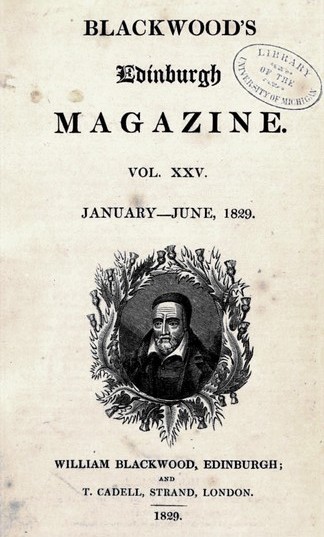
Among the various literary reviews which one could mention are the Monthly Review (1749-1845), the Edinbrugh Review (1802-1929), the Quarterly Review (1809-1967), the Examiner (1808-1881), the Westminister Review (1824-1914) and the Fortnightly Review (1865-1934).
Newspapers
Newspapers have their origin in the early 17th century and stem from short, single-sheet publications with news from abroad, a subject of natural interest to colonial powers - something which explains why they were popular in Holland (present-day Netherlands). They quickly began to proliferate in England so that by the mid-17th century there were several produced in London. During the interregnum of the monarchy (from 1649 to 1660) they were largely suppressed but during the Restoration period began to flourish again. The major newspapers, which have survived into our times, were first published in the 18th century, for instance The Times was founded in 1785.

In England national newspapers are published in London, the only significant exception being The Guardian (founded in 1821 as a weekly, after 1855 published as a daily) produced in Manchester. The term broadsheets is generally used nowadays for serious newspapers, usually in a large format, which are regarded as distinct from tabloids (in smaller format and of a more sensational character).